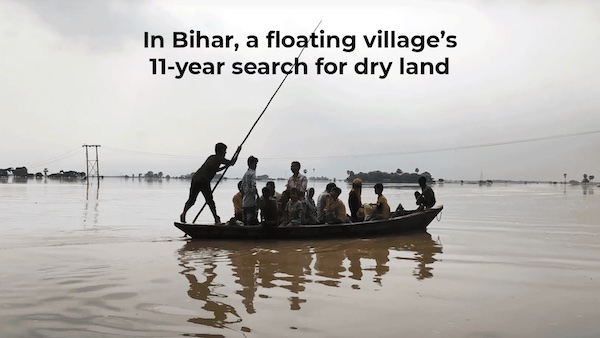Babhangama
This is a collection of articles archived for the excellence of their content. |
As in 2021
Atul Thakur, July 19, 2021: The Times of India

From: Atul Thakur, July 19, 2021: The Times of India
On a June afternoon, 60-year-old Muhammad Islam is returning home in a boat after buying groceries and vegetables. “There were fields here with a standing okra crop a few days ago,” he says looking at the water.
It’s not the first time the fields of Islam’s village, Babhangama Paschim in Bihar’s Muzaffarpur district, are flooded. Every June, he says, his anxiety levels peak as the monsoon hits Bihar, cutting off Babhangama from the outside world. For the next four months the course of his life – including the minutest detail of daily routine – is determined by the mood of the Bagmati.
Babhangama lies between the Bagmati’s north and south embankments that were built between 2007 and 2010 to confine the flood in a smaller area. On paper, Babhangama and 12 adjoining villages that bear the brunt of the flood are marked as ‘displaced’, but about 12,000 people still live in them. They were promised compensatory land outside the embankment but are still waiting after 11 years.
“At the start of the project, these villages had a population of 20,000, which has now reduced to 12,000 as the slightly well-off moved out. The remaining villagers still live in their old houses as they don’t have the money to move out,” says Sailendra Kumar, a local journalist who has been covering the issue for many years.
Babhangama’s plight is not hidden from the government. From the officials in the district to the scientists who analyse data from remote sensing satellites, everyone knows about it. In the 20 years between 1998 and 2019, for which satellite data has been analysed, the area was flooded more than 13 times, or almost every year. In official records it is marked as highly vulnerable to flooding.
A 2020 Flood Hazard Atlas made by National Remote Sensing Centre, National Disaster Management Authority and Bihar State Disaster Management Authority has classified many adjoining villages like Chihuta and Chainpur in Muzaffarpur’s Aurai block as ‘very high’ on the flood hazard scale.
A speck in the water
Babhangama’s suffering is real but it gets lost in the big picture of Bihar’s massive floods. The state accounts for around 17% of India’s flood-prone area, and for people outside the scenes of marooned villages and fields are little more than an annual spectacle.
Islam does not expect the world to sit up and take notice of Babhangama’s woes. “Reporters come to do routine flood stories. After a while nobody will give a damn,” he says with a straight face. “Except for a few days of community kitchen, there will be hardly any trace of the government. This is how it has always been.”
Then he adds, “We don’t want anything. Not mercy or relief material. We just want our allotted land so that we can build our houses in a safe place.”
Every home an island
After the first burst of rain, the school in Babhangama is flooded, the roads are submerged and you can’t keep your shoes dry without a boat. To reach Ranjeet Chaudhary’s ration shop you must wade through waist-deep water. Water has also entered many houses, leaving their toilets useless and the foul cocktail of flood and sewer water flows everywhere. There is no electricity as well.
You can’t imagine life in a marooned village from the comfort of a dry home. The initial flood has washed away their makeshift bamboo bridges, and daily chores will become harder in Babhangama as the monsoon progresses.
“Because officially it’s a displaced village, so many government schemes aimed at creating rural infrastructure are not provided here. Temporary structures like bamboo bridges are built by the villagers themselves,” says Kumar, adding, “The electricity supply also gets disconnected once the water rises and submerges the power lines around the village.”
“Technically, we are displaced people,” says Sarfe Alam, a Babhangama resident and member of the panchayat samiti. “There are many bureaucratic roadblocks as well because of disputes about the land survey, hence the allotment of compensatory land seems like a distant dream.”
The mother of Sanjeeda, a TB patient, is worried about her medicines, so is Muhammad Matin, a 65-year-old with diabetes and hypertension. An old, homeless man who has taken shelter in the village mosque says he has hardly any food. It is difficult to verify claims about scarcity of food and medicines. Eventually, they will manage like they do every year. Maybe they are exaggerating because who will listen to them otherwise?
“Tell me, how much suffering is too much suffering,” asks Muhammad Islam as he disembarks, checking my current of scepticism. As our boat turns back, some angry notes follow in its wake. Many of the residents are unhappy with us shooting pictures and videos of the village. They resent being reduced to a misery photo-op by journalists, NGOs and government officials.
“These photos make a mockery of our misery,” a woman shouts at the departing boat from behind the windows of her submerged house at the village’s entry.
Post-script
The rain relented after our visit and Babhangama had a few dry days. The water has receded from their homes, but the villagers know what lies ahead. They are bracing for the next flood, and possibly more waves of photographers since this is just the beginning of the rainy season.